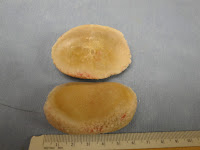 |
| Bladder stone |
Based on owner's report of excessive drinking and urinating, a blood glucose test was performed and her glucose was normal, ruling out diabetes. Tuffey's Temp., pulse and respirations were normal. Physical examination was uneventful except for a tender abdomen, making it difficult to feel anything unusual in the abdomen. Because Tuffey was nervous, she dribbled urine on our examination table. Her urine was bloody. A cystocentesis (a needle introduced into bladder) was preformed, with the needle hitting something very hard. A radiograph (left) was taken, 1-2 large bladder stone(s) was seen.
Due to the size of the stones, passing them was not an option, so Tuffey was taken to surgery for stone removal. Two stones were found, laying together like a clam. Each stone was approximately 6 cm x 4 cm and together they weighed 90.2 grams.
Bladder stones also known as uroliths, are one of the main diseases seen by veterinarians. They generally occur in dogs 4-6 years of age, although older dogs can develop stones as well.
 Small breed dogs are more prone than their larger counterparts, and some breeds are more prone than others. Female dogs are more prone to stones than males, however often an owner will not suspect there is a problem until the stone size gets large. Small sand-like stones can pass through the urethra without the owners awareness. This is not true for the male, since their urethra is longer, narrower and makes an s-turn as it exits the body (sigmoid flexure-where most stones will lodge). More often than not, bladder stones only become a problem once it blocks the flow of urine in the urethra. At such point, your dog won't be able to urinate properly. If not attended to right away, your dog might even die out of the complications of the disease especially if the crystallized stone is too big for the body to bear it.
Small breed dogs are more prone than their larger counterparts, and some breeds are more prone than others. Female dogs are more prone to stones than males, however often an owner will not suspect there is a problem until the stone size gets large. Small sand-like stones can pass through the urethra without the owners awareness. This is not true for the male, since their urethra is longer, narrower and makes an s-turn as it exits the body (sigmoid flexure-where most stones will lodge). More often than not, bladder stones only become a problem once it blocks the flow of urine in the urethra. At such point, your dog won't be able to urinate properly. If not attended to right away, your dog might even die out of the complications of the disease especially if the crystallized stone is too big for the body to bear it.The most common form of bladder stone is struvite, made of Magnesium ammonium phosphate. It is now believed that most struvite stones are infection induced, meaning that undetected bladder infections lead to the development of the stone. The urine becomes over-saturated with the minerals, that in turn attach to bacteria. Given time the minerals and bacteria layer upon each other making a nidus. Continued layering in this manner allows the nidus to grow into larger stone. It is believed that over saturation of urine with minerals may be associated with several factors, the most important are 1) urinary tract infections (UTI) with urease producing bacteria, and 2) formation of urine with large quantities of urea. Increased excretion of magnesium, ammonium, and phosphorus may increase the risk of stone formation; however, this is not required for initiation or growth of infection-induced struvite.
How do you know if your dog has a UTI or stones? Typically, you will observe frequent urination, with starting and stopping in multiple places are sometimes noted by owners, straining to urinate, or dribbles urine. Blood may or may not be observed. Your dog may have general weakness, lethargic, loss of appetite, vomiting, pain and just not acting themselves.
Your veterinarian will need to sample your dog's urine, may do a urine culture, and based on your dog's history and symptoms may do an ultrasound or take an x-ray. Sometimes, if the stones are small, antibiotics and a special diet may resolve your dog's disease. Large stones will need to be removed surgically. Antibiotic therapy will be maintained until your dog is negative for bacteria on culture.
As always, this veterinarian recommends regular checkups, they are your best defense against this rather common disease that affects man's loyal and trusted best friend.

No comments:
Post a Comment
Thanks for your comment. Make this blog your favorite and add RSS for updates.